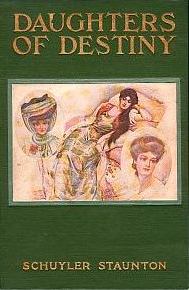Daughters of Destiny (novel)

First edition
|
|
| Author |
L. Frank Baum (as "Schuyler Staunton") |
|---|---|
| Illustrator | Thomas Mitchell Pierce Harold DeLay |
| Country | United States |
| Language | English |
| Genre | Adventure fiction |
| Publisher | Reilly & Britton |
|
Publication date
|
1906 |
| Media type | Print (hardcover) |
| Pages | 319 pp. |
Daughters of Destiny is a 1906 adventure novel written by L. Frank Baum, famous as the author of the Oz books. Baum published the novel under the pen name "Schuyler Staunton," one of his several pseudonyms. (Baum arrived at the name by adding one letter to the name of his late maternal uncle, Schuyler Stanton.)
The 1906 edition of the book featured eight illustrations, three by Thomas Mitchell Pierce and five by Harold DeLay. Pierce was a son-in-law of Baum's sister Harriet Alvena Baum Neal; he contributed illustrations to Baum's 1898 poetry collection By the Candelabra's Glare.
Baum had originally intended to call his novel The Girl in the Harem.
Overall, Baum dedicated his literary career to writing for children. For a brief period in the middle of the twentieth century's first decade, though, he made a concentrated effort to write for an adult audience as well. This effort produced two other novels in addition to Daughters of Destiny — The Fate of a Crown (1905), the first Schuyler Staunton novel, and The Last Egyptian (1908), published anonymously.
Writing to entertain, Baum chose exotic locales and melodramatic elements for these books. The Fate of a Crown is set in Brazil, and deals with the revolution of 1889; Daughters of Destiny is set even farther afield, in Baluchistan. In Baum's fiction, Baluchistan is still an independent state, though the region had fallen under the sway of the British Empire in the later nineteenth century.
Given his setting and subject, Baum's book had to involve the religion of Islam and an Islamic culture. While his text does deliver some stereotypical "dog of an infidel" dialogue, Baum for the most part takes a serious and respectful approach to Islam – something that was far from universal among Americans and Westerners of his generation. Baum recognizes the existence of Sunni Islam (he uses the term "Sunnite"), with its Imams ("Imaum"). Significantly, he introduces a "Grand Mufti" named Salaman in Chapter 15 of his book, and portrays him as a man of real and profound spirituality and wisdom.
...
Wikipedia
